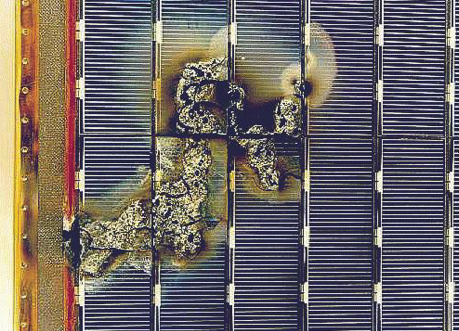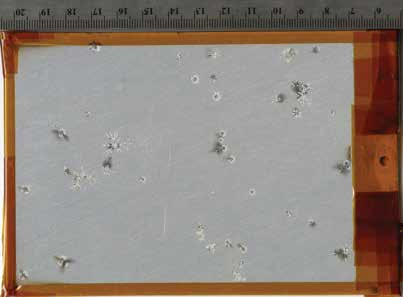This article is from the 2016 NESC Technical Update.
In April 2010, the Galaxy 15 telecommunications satellite was set adrift, wandering away from its assigned place in geosynchronous orbit. Ground controllers had lost contact with the spacecraft and were powerless to upload the commands it needed for executing station keeping maneuvers. As a result, the satellite began an uncontrolled drift in longitude, with the threat of getting in the way of other satellites, and potentially interfering with their transmissions. This uncontrolled drifting went on for months.
Reports in the scientific literature and space technology trade journals suggested Galaxy 15 was a victim of spacecraft charging. Hot electrons roaming the outer radiation belt had pelted the satellite, causing a negative charge to build on its surface — a charging event. And much like walking across a carpet and then touching a door knob, an electrostatic discharge ensued that knocked out its communications systems. It could no longer receive radio contact from its owner, Intelsat. It took 8 months to reestablish contact and successfully reposition the satellite in its desired orbit.
“Luckily for Galaxy 15, it wasn’t a loss of mission,” said Dr. Joseph Minow, NASA Technical Fellow for Space Environments. “They were able to establish a work around to recover use of the satellite.” Other satellites have not been so lucky. The Advanced Earth Observing Satellite 2 (ADEOS-II) in a high inclination low Earth orbit lost its power system in October 2003 and was never recovered. Engineering teams investigating the failure identified charging by high energy auroral electrons followed by an electrostatic discharge between the primary power cables as the likely cause of the power system damage. “The mission was a total loss. In geostationary orbit, there are a lot of hot electrons and during geomagnetic storms they build up. It’s a classic charging environment. Auroral charging is a similar problem, with hot electrons generated in the electric field structures above the Earth’s auroral zone that produce the northern and southern lights. Satellite designers have had to deal with these problems for years,” he said.
“Space is an interesting place. You tend to think of it as a big, empty void,” said Dr. Minow, who has worked to characterize space environments for space system design and operations for many NASA programs including the Space Shuttle, International Space Station, and James Webb Space Telescope (JWST). But while space is a vacuum, it is far from empty, he explains. “For spacecraft operating in a space environment, hazards lurk everywhere. And with the exception of meteoroids and orbital debris, most of those hazards are the product of a high energy charged particle radiation environment that are not even visible to the naked eye. And given that environment, spacecraft charging is inevitable,” said Dr. Minow. “Every spacecraft charges. It’s just a question of whether it has a detrimental impact on the spacecraft or not.”
A Hazard for Spacecraft
“The hazards caused by spacecraft charging are varied,” said Dr. Minow. If a charge builds up that is too big for the spacecraft’s material to hold, discharge arcs, which are essentially strong electrical currents, will occur. And depending on where those arcs go, they can damage electronic components, destroy sensors, or damage important materials such as thermal control coatings.
“They can also show up in electrical systems as phantom commands,” he said. The arcs can spoof the attitude control system, for example, causing attitude changes or spin anomalies. The arcs also emit electromagnetic radiation and cause interference and noise that can hamper both incoming and outgoing command and control as well as science data signals.
“Charging can have big impacts on solar arrays and photovoltaic power systems,” added Dr. Minow. “You can get arcing between solar cells on the solar array. Currents can get bigger and bigger, which sustains the arcing, which can destroy the entire solar array. There have been cases where satellites have lost major parts of or all of their power systems. And that’s catastrophic. You can completely lose the mission.”
Even seemingly benign charging that does not affect the spacecraft itself can have a major impact on science satellites that measure charged particles, such as the Magnetospheric Multiscale Mission, which employs several satellites to study the Earth’s magnetosphere. Even a small charge on the spacecraft can interfere with the satellites’ detection abilities of low energy “thermal” plasma. Active charge control systems are frequently employed by these kinds of science missions to suppress charging during times when critical measurements are to be made.
Mitigating the Hazard
In his role as the NASA Technical Fellow for Space Environments, Dr. Minow has assembled teams to work on NESC assessments to help mitigate spacecraft charging threats to NASA missions. For example, the JWST spacecraft and telescope systems are well designed and well equipped for its stay in orbit about the Sun-Earth Lagrange point 2 (L2) about 1.5 million kilometers from Earth. However, mission risks can be reduced by avoiding exposure to extreme solar flare particles and severe charging events during transit of the Earth’s radiation belts in the hours right after launch. He and the NESC team will help the JWST Program develop and assess the effectiveness of proposed launch constraints designed to protect the spacecraft during the first three quarters of a day on its month-long journey to L2.
“Charging has always been a problem,” said Dr. Minow, for as long as NASA and other space programs have been sending vehicles into space. “There were a lot of charging related anomalies in the 70s and 80s, but the number is dropping, because the more we understand it, the better we can build satellites to operate successfully,” he said. “Every time there is a failure due to charging, we figure it out to make sure it doesn’t happen again. On average, the failures per decade is going down, which is good. It means we understand what is happening and spacecraft designers are following good design practices that mitigate charging.”
Dr. Minow said, “The best solution to mitigating charging hazards is good design. Just turning off the sensitive systems to avoid geomagnetic storms isn’t practical for most satellites. Good material selection is important. If we build satellites for geostationary orbit with conductive coatings on the outside, the arc will go out into space. Differential charging is the worst because arcs originating in one location on a spacecraft can damage systems on another part of the spacecraft. Fortunately, design techniques to minimize the amount of differential charging are well understood.” Along with good design is testing, particularly in environments that expose the spacecraft components to arcing. And more design and testing is being done with computer modeling, he notes. “We can simulate the charge build up and variations in voltage across the vehicle. We can see the motion of the particles. A combination of both analytical work and testing yields the best satellite design,” he said.
The study of space environments has kept Dr. Minow captivated for many years. “It is really interesting — the interaction of spacecraft with the space environment. It’s a mix of fundamental physics and science, with a really important application,” he said. “It’s a nice combination of basic and applied science.”




























